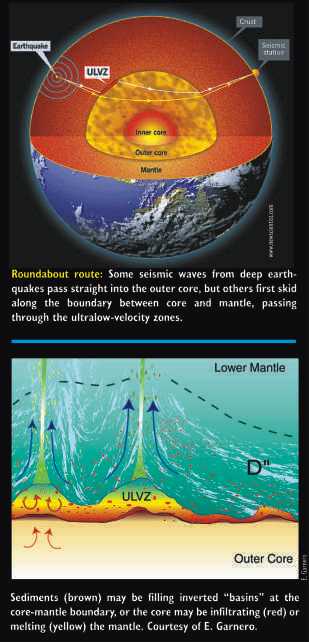
Geotimes Home | AGI Home | Information Services | Geoscience Education | Public Policy | Programs | Publications | Careers
| Geotimes Home | Calendar | Classifieds | Subscribe | Advertise |
| Geotimes
Published by the American Geological Institute |
January
2001
Newsmagazine of the Earth Sciences |


The Earth’s rotation is subject to periodic variations called nutations
— a wobble along Earth’s axis. This wobble is ascribed to the Sun and Moon’s
gravitational pull, which tugs on Earth’s magnetic field. The pulling sloshes
around Earth’s liquid interior layers. The planet’s magnetic field, which
originates in the solid iron core, could be carried through a conducting
layer at the core-mantle boundary, the scientists say. The magnetic field
could then link the core and mantle magnetically, and pull on the solid
mantle to make the planet nutate, or wobble, slightly.
According to current theories about the formation of Earth, the solid
inner core has been cooling and solidifying for billions of years. As it
cools, the lighter iron alloys separate from the pure iron and move outward
to the liquid outer core. The liquid layer must then chemically equilibrate
with the lower mantle. Bruce Buffett, a geophysicist from the University
of British Columbia in Vancouver, seismologist Edward Garnero of Arizona
State University in Tempe, and mineral physicist Raymond Jeanloz of the
University of California, Berkeley, reported in the Nov. 17 Science that
the light iron alloys will react with the lower silicate mantle to make
iron silicates. A slow inverted rain of iron silicate “sediments” moves
out from the core because the sediments are less dense than the alloys.
The sediments rise and collect unevenly at the boundary between the outer
liquid core and lower mantle. However, some liquid iron is still found
in spaces between the sediments. This is the key to Buffett’s theory. Under
the pressure of accumulating sediments, some of the iron will be squeezed
out. The remaining iron, however, would provide enough conductivity in
the new layer to explain Earth’s wobble.
A layer of high conductivity could account for another geophysical
phenomenon: areas of low seismic velocity found at the core-mantle boundary.
Most information about the inner Earth is inferred from the study of how
seismic waves pass through the planet. Within a few tens of kilometers
of the core-mantle boundary, seismic waves slow down, possibly more than
10 percent relative to the average velocity of waves in the lower mantle.
Historically, these ultralow-velocity zones (ULVZs) were attributed to
partial melting of the lower mantle. However, the presence of liquid iron
in the sediments could significantly slow down seismic waves and possibly
explain the ULVZs, Buffett says.
One test of the theory would be to correlate the location of ULVZs
with topographic maps of the core-mantle boundary. However, better maps
will be needed, says Quentin Williams of the University of California,
Santa Cruz, who believes that while core sedimentation could explain the
ULVZs, it is still “a speculative story that’s going to be difficult to
verify.” Either way, the seismic techniques will have to be improved to
better distinguish core and mantle sediments, just as they help to distinguish
between oceanic and continental sediments.
Audrey Slesinger
Geotimes contributing writer
 |
Geotimes Home | AGI Home | Information Services | Geoscience Education | Public Policy | Programs | Publications | Careers |